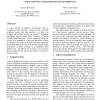Free Online Productivity Tools
i2Speak
i2Symbol
i2OCR
iTex2Img
iWeb2Print
iWeb2Shot
i2Type
iPdf2Split
iPdf2Merge
i2Bopomofo
i2Arabic
i2Style
i2Image
i2PDF
iLatex2Rtf
Sci2ools
WSC
1998
1998
Simulating Haul Durations for Linear Scheduling
A major portion of highway construction work is comprised of linear activities. A linear activity is one that progresses along a path (non-stationary), as it does it is complete and another activity can proceed. Traditional scheduling methods model linear activities as having constant production rates. Linear scheduling allows an activity to be modeled as a line with dimensions of time and location. The slope of the line at any point represents the planned productivity rate of the activity. Predicting the productivity of linear activities is a scheduler's most difficult task. Simulation can be used to give planners greater insight into the factors that influence an activity's production rate.
Linear Activities | Linear Activity | Model Linear Activities | Modeling And Simulation | WSC 1998 |
| Added | 01 Nov 2010 |
| Updated | 01 Nov 2010 |
| Type | Conference |
| Year | 1998 |
| Where | WSC |
| Authors | David J. Harmelink, Maria Andrea Bernal |
Comments (0)

